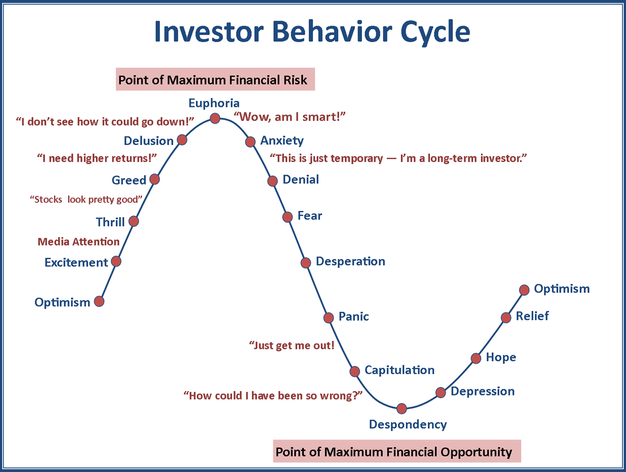Market Corrections And Investor Behavior: A Comparative Analysis Of Pros And Individuals

Table of Contents
Market corrections are a normal part of the economic cycle, characterized by a significant drop in market prices. These periods of volatility, often defined as a 10% or greater decline from a recent peak, can trigger fear and uncertainty among investors. However, the impact of these market corrections differs drastically between professional investors and individual investors. This article will explore the contrasting behaviors and strategies employed by these two groups during market corrections, analyzing their approaches to risk management, investment decisions, and overall portfolio performance. Understanding these differences is crucial for both professional and individual investors to navigate market volatility effectively and to potentially profit from these inevitable market events.
Professional Investors and Market Corrections:
Risk Management Strategies:
Professional investors, such as fund managers and institutional traders, often employ sophisticated risk management techniques to mitigate the impact of market corrections. These strategies include:
- Diversification across asset classes: Professionals rarely concentrate their investments in a single asset class. Instead, they diversify across stocks, bonds, real estate, commodities, and alternative investments to reduce overall portfolio risk. This diversification strategy helps to cushion the blow of declines in any one sector.
- Hedging strategies: These strategies involve using financial instruments, such as options or futures contracts, to offset potential losses in other parts of the portfolio. Hedging can significantly reduce downside risk during market corrections.
- Stress testing portfolios: Sophisticated models are used to simulate various market scenarios, including severe downturns. This allows professionals to assess their portfolio's vulnerability and adjust their strategies accordingly, before a correction occurs.
- Quantitative models: Professionals often use advanced quantitative models to analyze market data, identify trends, and predict potential market movements. These models can help them anticipate corrections and make timely adjustments.
Investment Decisions During Corrections:
Professional investors often view market corrections as buying opportunities. Their approach is typically characterized by:
- Identifying undervalued assets: Corrections often create opportunities to acquire high-quality assets at discounted prices. Professionals leverage their research capabilities to identify companies with strong fundamentals that have been unfairly punished by the market.
- Contrarian investing: They often go against the prevailing market sentiment, buying when others are selling. This contrarian approach can yield significant returns in the long run.
- Long-term investment horizon: They maintain a long-term perspective, understanding that short-term market fluctuations are a normal part of the investment cycle. They are less likely to panic sell during a market correction.
- Resource utilization: Professionals have access to extensive research resources, expert analysts, and advanced technological tools that enhance their decision-making process during market corrections.
Individual Investors and Market Corrections:
Emotional Responses to Market Volatility:
Individual investors, unlike professionals, are often more susceptible to emotional biases during market corrections. This can lead to:
- Fear and panic selling: The fear of further losses can trigger impulsive decisions, resulting in the sale of assets at a loss—a classic example of panic selling, which often exacerbates market downturns.
- Short-term focus: Individual investors may focus on short-term market noise, reacting to daily price fluctuations rather than focusing on the long-term fundamentals of their investments.
- Lack of diversification: Many individual investors hold undiversified portfolios, making them highly vulnerable to market downturns in specific sectors.
- Herd behavior: They may follow the crowd, leading to a self-fulfilling prophecy where selling pressure increases as more investors panic.
Investment Strategies During Corrections:
Individual investors often lack the resources and expertise to navigate market corrections effectively. This can result in:
- Poor investment decisions: Without proper research and understanding, individual investors may make poorly informed decisions during corrections, potentially exacerbating their losses.
- Susceptibility to misinformation: They might be more easily influenced by misleading information or market manipulation.
- Lack of long-term perspective: A short-term focus can lead to impulsive actions that contradict a long-term investment strategy.
- Limited access to resources: Individual investors often lack the access to advanced research and analytical tools available to professionals.
Comparative Analysis: Pros vs. Individuals:
Key Differences in Approach:
The contrasting approaches of professional and individual investors during market corrections are significant:
- Data vs. Emotion: Professionals rely on data-driven analysis and quantitative models, whereas individuals are more prone to emotional decision-making.
- Resources and Information: Professionals have access to superior research, analytical tools, and information networks.
- Long-Term vs. Short-Term: Professionals focus on long-term growth, while individuals may prioritize short-term gains.
- Risk Management: Professionals are better equipped to manage risk and volatility through sophisticated strategies.
Lessons for Individual Investors:
Individual investors can learn from the strategies of professionals and improve their ability to weather market corrections:
- Long-Term Strategy: Develop a well-defined, long-term investment plan based on your financial goals and risk tolerance.
- Diversification: Diversify your portfolio across various asset classes to reduce risk.
- Financial Education: Continuously educate yourself about market dynamics, investment strategies, and risk management techniques.
- Emotional Discipline: Avoid making impulsive decisions based on fear or greed; stick to your investment plan.
- Seek Professional Advice: Consider consulting a financial advisor for personalized guidance.
Conclusion:
Market corrections are an inherent part of the investment landscape. While professional investors often view these periods as strategic buying opportunities, individual investors frequently struggle due to emotional responses and a lack of resources. By understanding the key differences in approach and adopting a more disciplined, data-driven investment strategy, individual investors can significantly improve their ability to navigate market corrections and potentially profit from these periods of volatility. Don't let fear dictate your investment choices during future market corrections; instead, develop a robust, long-term investment strategy and learn to manage your emotional responses to market fluctuations. Take control of your financial future by focusing on sound investment principles and appropriate risk management during these periods of market corrections.

Featured Posts
-
 Auto Dealers Double Down Against Electric Vehicle Mandates
Apr 28, 2025
Auto Dealers Double Down Against Electric Vehicle Mandates
Apr 28, 2025 -
 Aaron Judges Historic Home Run Matching Babe Ruths Yankees Mark
Apr 28, 2025
Aaron Judges Historic Home Run Matching Babe Ruths Yankees Mark
Apr 28, 2025 -
 Cleveland Browns Select Shedeur Sanders In Nfl Draft
Apr 28, 2025
Cleveland Browns Select Shedeur Sanders In Nfl Draft
Apr 28, 2025 -
 Remembering The 2000 Yankees Victory Against The Royals
Apr 28, 2025
Remembering The 2000 Yankees Victory Against The Royals
Apr 28, 2025 -
 Deportation Fight Federal Judge To Review Case Of 2 Year Old U S Citizen
Apr 28, 2025
Deportation Fight Federal Judge To Review Case Of 2 Year Old U S Citizen
Apr 28, 2025
